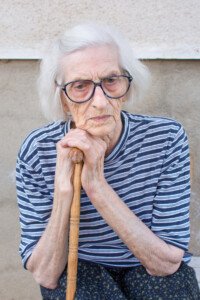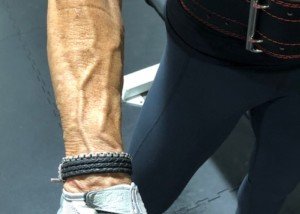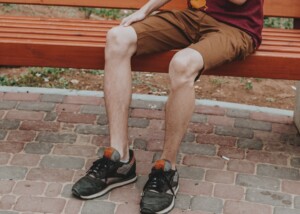
Thin, especially in older age, doesn’t always mean good health & fitness.
Of course, obesity in old age is a very serious problem, but “skinny muscle-less” is also a serious problem.
Look at the man below. He’s thin and visibly very frail. Look at those legs. There’s nothing healthy or fit about legs like that.
Where’s the muscle?
People underestimate the importance of muscle. Muscle is a very valuable tissue. We should strive hard throughout our life not to lose it!
This man is suffering from muscle-wasting resulting from the combination of an aging body and lack of weight-bearing exercise.
Not all people who don’t exercise become fat in later life. Chances are pretty high that senior-aged men and women who are skinny muscle-less (or skinny frail) hardly eat.
Not all older people who look like this have cancer either.
The true Fountain of Youth is weightlifting. What this can do to prevent the classic signs of aging is just staggering.

Shutterstock/ Lestertair
The Perils of Muscle Loss
In a body that has not been strength trained, muscle loss begins kicking in at around age 30, to the tune of five pounds lost for every 10 years after that.
Do the math: By age 80 a person will have lost 25 pounds of muscle mass – assuming they’ve avoided consistent strength training.
Age related muscle loss is called sarcopenia. In sedentary people it often picks up steam in the mid-70s. Loss of muscle is intimately linked with risk of falls and fractures.
It isn’t just the fall that breaks a hip, but the hip bone is porous from lack of weight-bearing exercise. It doesn’t take much to snap a porous bone.
Though some muscle loss also eventually affects the most hardcore bodybuilders as they age (sarcopenia has causes other than inactivity), its rate of progression is drastically impeded by strength training.
Compare Sharon Smith, 71, to the average 71-year-old woman.

Sharon Smith shows the way a 71-year-old woman’s shoulders, back and arms should be.
“Exercising and building muscle mass can keep someone from becoming a ‘frail elderly’. That is an older person who is weak, has trouble getting up from a chair, needs assistance with walking,” explains Dana Simpler, MD, an internal medicine physician with Mercy Medical Center in Baltimore.
Dr. Simpler continues, “It turns out our muscle fibers die out as we age because our nerve fibers die out. BUT, if you exercise — you can keep the same muscle mass that you currently have because the nerve and muscle fibers won’t die off when you exercise regularly.”
Elderly people with severe sarcopenia will also suffer from aches and pains, balance issues and a body that gets hurt easily. Just a bump to the arm can leave it feeling very sore for days.
It’s never too late to add lean muscle from strength training—even in the advanced elderly.
If an elderly person can pick up a coffee cup, they can lift weights – even it it’s only soup cans to start.
Those soup cans may very well turn into five-pound dumbbells. Then eight-pounders. Then 10, then 15. Don’t ever say, “It’s too late; I’m too old to start strength training.”
Lifting weights can improve your appetite and help you get out of that skinny-frail rut.
Sharon Smith has been in the fitness industry for 25+ years and specializes in the over-40 client.

Dr. Simpler received her medical degree from University of Maryland School of Medicine and has been in practice for over 25 years.
 Lorra Garrick is a former personal trainer certified through the American Council on Exercise. At Bally Total Fitness she trained women and men of all ages for fat loss, muscle building, fitness and improved health.
Lorra Garrick is a former personal trainer certified through the American Council on Exercise. At Bally Total Fitness she trained women and men of all ages for fat loss, muscle building, fitness and improved health.
.


























